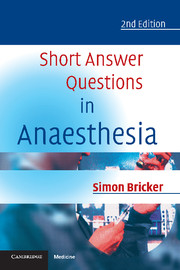Book contents
- Frontmatter
- Contents
- Preface
- Preface to the 1st edition
- Abbreviations
- 1 Advice on answering short answer questions
- 2 General Anaesthesia
- 3 Anaesthesia and Medical Disease
- 4 Medicine and Intensive Care
- 5 Obstetric Anaesthesia and Analgesia
- 6 Paediatric Anaesthesia
- 7 Neuroanaesthesia
- 8 Acute and Chronic Pain
- 9 Trauma and Emergency Anaesthesia
- 10 Anatomy, Applied Anatomy and Regional Anaesthesia
- 11 Pharmacology and Applied Pharmacology
- 12 Clinical Measurement and Equipment
- 13 Cardiac and Thoracic Anaesthesia
- Index
7 - Neuroanaesthesia
Published online by Cambridge University Press: 05 February 2014
- Frontmatter
- Contents
- Preface
- Preface to the 1st edition
- Abbreviations
- 1 Advice on answering short answer questions
- 2 General Anaesthesia
- 3 Anaesthesia and Medical Disease
- 4 Medicine and Intensive Care
- 5 Obstetric Anaesthesia and Analgesia
- 6 Paediatric Anaesthesia
- 7 Neuroanaesthesia
- 8 Acute and Chronic Pain
- 9 Trauma and Emergency Anaesthesia
- 10 Anatomy, Applied Anatomy and Regional Anaesthesia
- 11 Pharmacology and Applied Pharmacology
- 12 Clinical Measurement and Equipment
- 13 Cardiac and Thoracic Anaesthesia
- Index
Summary
What are the causes of raised intracranial pressure? Describe the clinical features and explain the underlying pathophysiological mechanisms.
Head injury is common and there are many other disorders which cause raised intracranial pressure. Knowledge of the basic underlying mechanisms is important both for diagnosis and for rational management.
Introduction
The skull of an adult is in effect a rigid box which contains brain tissue, blood and CSF. There is very limited scope for compensation and an increase in the volume of one component invariably results in an increase in ICP unless the volume of another component decreases.
Causes
Intracranial contents comprise: brain tissue ~1400–1500 g, blood ~100–150 ml, CSF ~110–120 ml and ECF <100 ml.
ICP is raised by mass lesions which increase brain, bone or meningeal tissue volume.
— Neoplasms (of brain, meninges or bone).
— Infection with formation of brain abscess.
ICP is raised by conditions which impede drainage of CSF (produced at 0.4 ml min–1) and increase its volume.
— Hydrocephalus: congenital, due to blocked shunt, caused by trauma, tumour or infection.
ICP is raised by conditions which increase non-CSF fluid volume.
— Blood: intracranial haemorrhage (trauma, aneurysm, AV malformation, etc.).
— Oedema: following trauma, infection, metabolic disorder, hypoxia, venous obstruction, hydrostatic pressure (steep or prolonged Trendelenburg).
- Type
- Chapter
- Information
- Short Answer Questions in Anaesthesia , pp. 203 - 214Publisher: Cambridge University PressPrint publication year: 2002



